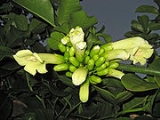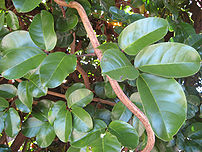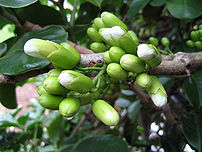
Tecomanthe speciosa
Encyclopedia
A solitary plant of Tecomanthe speciosa or the Three Kings Vine was first discovered on the Three Kings Islands
, 55 km off the northern tip of New Zealand
, during a scientific survey in 1945. No other specimens have ever been found in the wild. Tecomanthe
is a tropical genus not otherwise represented in New Zealand. Four other species of Tecomanthe occur in Queensland
, Indonesia
, New Guinea
, and the Solomon Islands
.

 Tecomanthe speciosa is a vigorous twining climber growing up to 10m in height. The glossy, thick compound leaves consist of up to five leaflets. In autumn or early winter it bears long cream-coloured tubular flowers that emerge directly from the stem in large clusters. The flowers appear to be adapted to be pollinated by bat
Tecomanthe speciosa is a vigorous twining climber growing up to 10m in height. The glossy, thick compound leaves consist of up to five leaflets. In autumn or early winter it bears long cream-coloured tubular flowers that emerge directly from the stem in large clusters. The flowers appear to be adapted to be pollinated by bat
s, despite the fact that bats are not part of the present-day fauna
of the Three Kings Islands (though they may once have been present). Nevertheless, the flowers of plants growing in cultivation are readily pollinated by a large number of native and exotic bird
s.
s, which had been introduced to the islands, had reduced the entire population to a single specimen on Great Island, making it one of the world’s most endangered plants. The remaining specimen grew on a cliff that was so steep, that even the goats could not reach it. It was rescued by horticulturalists who took cuttings from the original plant and goats were subsequently eradicated from the island. The original specimen still grows in the wild, and has developed more vines through the natural process of layering in the years since its discovery.
It has not yet been formally assessed for the IUCN Red List
, but a preliminary assessment of the conservation status of all New Zealand vascular plants found T. speciosa to be "Nationally Critical".
Three Kings Islands
The Three Kings Islands or Manawa Islands are a group of 13 islands about northwest of Cape Reinga, the northernmost point of the North Island of New Zealand, where the South Pacific Ocean and Tasman Sea converge. They measure about 4.86 km² in area...
, 55 km off the northern tip of New Zealand
New Zealand
New Zealand is an island country in the south-western Pacific Ocean comprising two main landmasses and numerous smaller islands. The country is situated some east of Australia across the Tasman Sea, and roughly south of the Pacific island nations of New Caledonia, Fiji, and Tonga...
, during a scientific survey in 1945. No other specimens have ever been found in the wild. Tecomanthe
Tecomanthe
Tecomanthe is a genus of 5 species of tropical or subtropical forest lianes in the family Bignoniaceae. They have attractive trumpet-like flowers and glossy leaves. They are native to Australia, Indonesia, New Guinea, New Zealand, and the Solomon Islands....
is a tropical genus not otherwise represented in New Zealand. Four other species of Tecomanthe occur in Queensland
Queensland
Queensland is a state of Australia, occupying the north-eastern section of the mainland continent. It is bordered by the Northern Territory, South Australia and New South Wales to the west, south-west and south respectively. To the east, Queensland is bordered by the Coral Sea and Pacific Ocean...
, Indonesia
Indonesia
Indonesia , officially the Republic of Indonesia , is a country in Southeast Asia and Oceania. Indonesia is an archipelago comprising approximately 13,000 islands. It has 33 provinces with over 238 million people, and is the world's fourth most populous country. Indonesia is a republic, with an...
, New Guinea
New Guinea
New Guinea is the world's second largest island, after Greenland, covering a land area of 786,000 km2. Located in the southwest Pacific Ocean, it lies geographically to the east of the Malay Archipelago, with which it is sometimes included as part of a greater Indo-Australian Archipelago...
, and the Solomon Islands
Solomon Islands
Solomon Islands is a sovereign state in Oceania, east of Papua New Guinea, consisting of nearly one thousand islands. It covers a land mass of . The capital, Honiara, is located on the island of Guadalcanal...
.
Description


New Zealand Lesser Short-tailed Bat
The Lesser Short-tailed Bat, Mystacina tuberculata or Pekapeka-tou-poto in Māori, is one of only two species of short-tailed bats in the family Mystacinidae, which is endemic to New Zealand.-Description:...
s, despite the fact that bats are not part of the present-day fauna
Fauna
Fauna or faunæ is all of the animal life of any particular region or time. The corresponding term for plants is flora.Zoologists and paleontologists use fauna to refer to a typical collection of animals found in a specific time or place, e.g. the "Sonoran Desert fauna" or the "Burgess shale fauna"...
of the Three Kings Islands (though they may once have been present). Nevertheless, the flowers of plants growing in cultivation are readily pollinated by a large number of native and exotic bird
Bird
Birds are feathered, winged, bipedal, endothermic , egg-laying, vertebrate animals. Around 10,000 living species and 188 families makes them the most speciose class of tetrapod vertebrates. They inhabit ecosystems across the globe, from the Arctic to the Antarctic. Extant birds range in size from...
s.
Conservation
Although the plant may once have been common on the Three Kings, by the time of its discovery goatGoat
The domestic goat is a subspecies of goat domesticated from the wild goat of southwest Asia and Eastern Europe. The goat is a member of the Bovidae family and is closely related to the sheep as both are in the goat-antelope subfamily Caprinae. There are over three hundred distinct breeds of...
s, which had been introduced to the islands, had reduced the entire population to a single specimen on Great Island, making it one of the world’s most endangered plants. The remaining specimen grew on a cliff that was so steep, that even the goats could not reach it. It was rescued by horticulturalists who took cuttings from the original plant and goats were subsequently eradicated from the island. The original specimen still grows in the wild, and has developed more vines through the natural process of layering in the years since its discovery.
It has not yet been formally assessed for the IUCN Red List
IUCN Red List
The IUCN Red List of Threatened Species , founded in 1963, is the world's most comprehensive inventory of the global conservation status of biological species. The International Union for Conservation of Nature is the world's main authority on the conservation status of species...
, but a preliminary assessment of the conservation status of all New Zealand vascular plants found T. speciosa to be "Nationally Critical".

